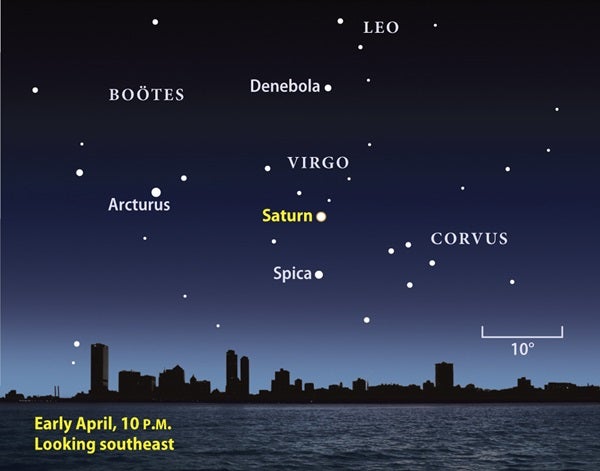As April begins, Saturn will be the only planet visible before midnight. The best views occur later in the evening as it climbs southeast, with prime viewing happening at its maximum altitude, due south and about halfway to the zenith from mid-northern latitudes. “It’s always a lovely sight, but Saturn will look particularly stunning this month,” says Astronomy Senior Editor Richard Talcott.
The planet lies closer to Earth during opposition (about 800 million miles, or 1.3 billion kilometers) than at any other time this year, so it’ll appear bigger and more detailed through a telescope. And Saturn’s main attraction, its fabulous ring system, will tip 9º to our line of sight, giving a wonderful view of its various features all month. The planet’s rings will roughly double its diameter, and Saturn’s equator will be 12 percent greater than its polar diameter. (The flattening is due to its gaseous atmosphere and quick rotation.)
Saturn’s opposition also affords observers a great opportunity to become familiar with the largest of its many satellites — Titan, Tethys, Dione, and Rhea. Each should be relatively easy to spot through small scopes. “All in all, it’s a great time to admire the sixth planet and its surroundings,” says Talcott. “Whether you’re interested in its rings, moons, or Saturn itself, this is the time to look up.”
Fast facts about Saturn
- Saturn is the second-largest planet in the solar system, and more than 750 Earths could fit inside.
- Saturn is the only planet less dense than water, and it weighs only 95 times as much as Earth. This also means it would float, if you could find a body of water big enough.
- It takes Saturn about 29 years to orbit the Sun once, but a little less than 11 or so hours to rotate completely.
- From Saturn, the Sun appears 1 percent as bright as it does on Earth.
- Saturn’s quick rotation flattens it slightly, so its polar diameter is only 89 percent of its equatorial diameter.
- Saturn’s famous rings tilt at an angle of 27.3° with respect to its orbit. They can be as thick as 33 feet (10 meters) thick, and are made almost entirely of ice.
- Saturn is host to a variety of famous moons, inclujding the “earthlike moon” Titan, the “death star moon” Mimas, the “erupting moon” Enceladus and the “two-faced moon” Iapetus
- Saturn’s odd weather systems have created an unusually regular hexagon atop the north pole, one of the most curious features in the solar system.
- StarDome: Locate Saturn in your evening sky with our interactive star chart.
- Sign up for our free weekly e-mail newsletter.











